
No country with a dominantly young population can afford to ignore an upswell in despair and rage among its youth.
The recent political upheaval in neighbouring Bangladesh triggered by student-led protests offers many lessons. One critical takeaway: that economic growth alone cannot stave off turmoil. Bangladesh won high praise for its investments in human capital, notably female education and health care and strong economic credentials in recent years, with its per capita GDP, life expectancy and female workforce participation rate all surpassing that of India, but underlying impressive data points are structural challenges facing the Bangladeshi economy, said a recent Chatham House report by Dr Chietigj Bajpaee and Dr Patrick Schröder.
These include high inflation and slowing growth amid the country’s export-dependent economy. The country’s readymade garment industry accounts for 83 per cent of the country’s total export earnings, which makes it highly vulnerable to external shocks, such as from the Covid-19 pandemic to the war in Ukraine. Most significantly, the authors observe, “the country faces high levels of youth unemployment with 18 million people — almost a fifth of those aged between 18-24 in a population of 170 million people — not working or in education. This is what made the issue of public sector job quotas a lightning rod for anti-government unrest, with 400,000 new graduates competing for 3,000 civil service jobs.”
India, however, is not Bangladesh.
India’s economy is much bigger and much more diverse.
But youth unemployment remains one of India’s biggest challenges, despite economic growth.
India should read the right lesson from the upheaval, as Andy Mukherjee, a Bloomberg opinion columnist, reminds us.
“In 2022, 30 per cent of Bangladesh’s 15-24-year-olds were not in employment, education, or training. In India, the corresponding estimate for last year from the International Labor Organisation is 23.5 per cent. Youth unemployment is at 16 per cent in both” he pointed out in a recent column.
Official narratives in India often paper over the stark reality of available “work” being increasingly temporary, precarious, and low-paid. “Although there was a rise in youths in regular employment over the past two decades, this does not necessarily indicate improvement in employment quality: a large portion of them lacked a written contract, a long-term (three or more years) contract and social security benefits. In 2022, only 30.7 per cent of young regular workers had a written contract, and only 10.2 per cent were in regular formal employment or receiving social security benefits. Notably, the share of regular workers with a written contract and a long-term written contract was much smaller among youths than adults,” noted the India Employment Report 2024, brought out by the Institute for Human Development and International Labour Organisation, in March this year. The report also noted that the problem of unemployment in India has become increasingly concentrated among the youth, especially the educated ones in urban areas.
The Narendra Modi government dismissed concerns flagged in that report which stated that youth form nearly 83 per cent of the unemployed workforce in India. “We still have a slave mentality because we always depended on foreign ratings. We need to come out of it and trust organisations in our country,” quipped Anurag Thakur, then information and broadcasting minister.
But a problem does not cease to exist just because it is being glossed over.
The ILO has just come out with a new report titled Global Employment Trends for Youth 2024 which expresses concern over the number of 15-24-year-olds who are not in employment, education or training (NEET), especially in emerging and developing economies.
One in five young people, or 20.4 per cent, globally were NEET in 2023. Two in three of these NEETs were female. For the youth who do work, the report notes the lack of progress in gaining decent jobs. Three in four young workers in low-income countries will get only a self-employed or temporary paid job.
These are trends which cannot be wished away.
There is an urgent need to unlock the potential of micro, small and medium-sized enterprises (MSMEs) in a country like India that is labour surplus and where the employment landscape is dominated by an unorganised sector, says Deepanshu Mohan, professor of economics and dean, O.P. Jindal Global University, also director of JGU’s Centre for New Economics Studies and a visiting professor at the London School of Economics.
“India’s big ticket manufacturing companies are not labour intensive. The big problem for Indian youth in the 15-24 age group is that the unorganised, job-absorbing MSME sector is not doing well. There have been a series of shocks, starting with demonetisation, the way the GST has been implemented and finally Covid-19. All of these have knocked the MSMEs. India needs to focus more on and prioritise MSMEs which have had a sub-optimal growth in recent years,” says Prof. Mohan.
There are other critical barriers. As Prof. Mohan notes, millions coming out of academic institutions are not employable and there is a mismatch between what the youth have absorbed while in these educational institutions and the requirements of industry today.
Chanting the mantra of skilling alone will not suffice. “The skills development centres cannot be part of a top-down, national programme. There must be decentralisation — such centres are more suited to the needs of the market when driven by local civil society organisations, district administrations, local factories which better understand the demands of the local market,” notes Prof. Mohan. Employability quotient is another critical issue. Growing numbers of educated youth lack functional skills required by industry. There is an urgent need to focus on specific skill sets, such as data analysis, critical thinking, ability to process information required for higher paid jobs, he adds.
MSME jobs have had seasonal spikes but on average, MSME performance and employment absorption rates are not where they used to be in a peaking period (2001-2011).
Last month, minister for MSMEs Jitan Ram Majhi told the Lok Sabha that of a million registered MSMEs, 49,342 have closed, resulting in the loss of 317,641 jobs. This happened in the last ten years. Maharashtra saw the most closures, with over 12,000 MSMEs shutting down.
This year’s Budget flags several measures to boost the MSME sector like a credit guarantee scheme for machinery loans without collateral, a self-financing guarantee fund offering up to Rs 100 crores per borrower, and a new assessment model for MSME credit by public sector banks based on digital footprints.
The spotlight should remain on MSMEs and jobs.
The bottomline — India, a country with a median age of 28, and a myriad aspirations can’t have a bright future if its youth loses hope.
